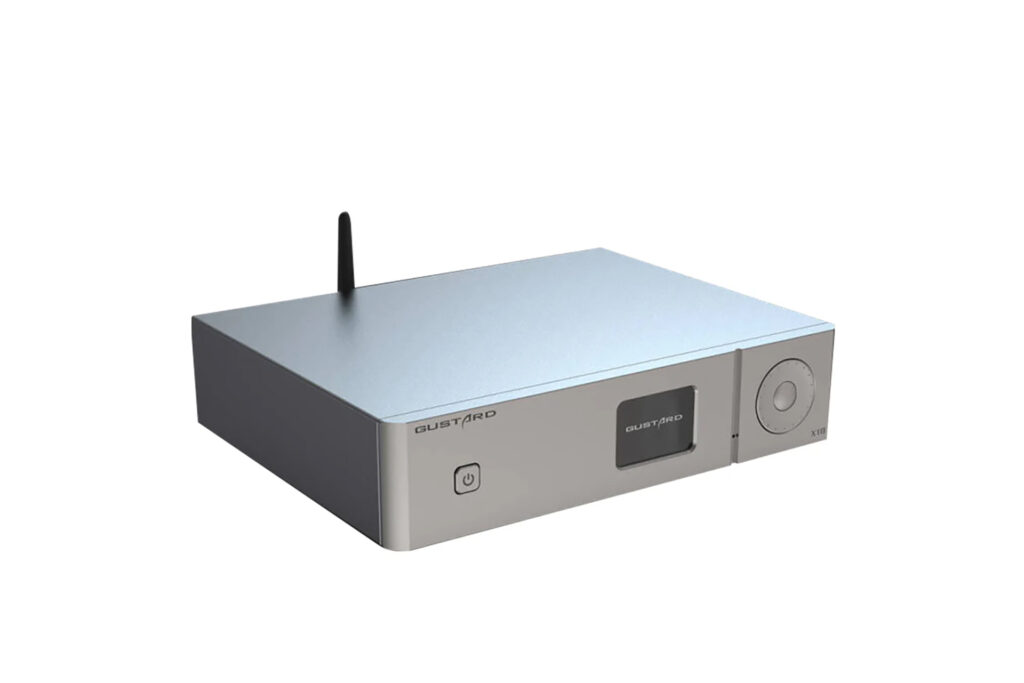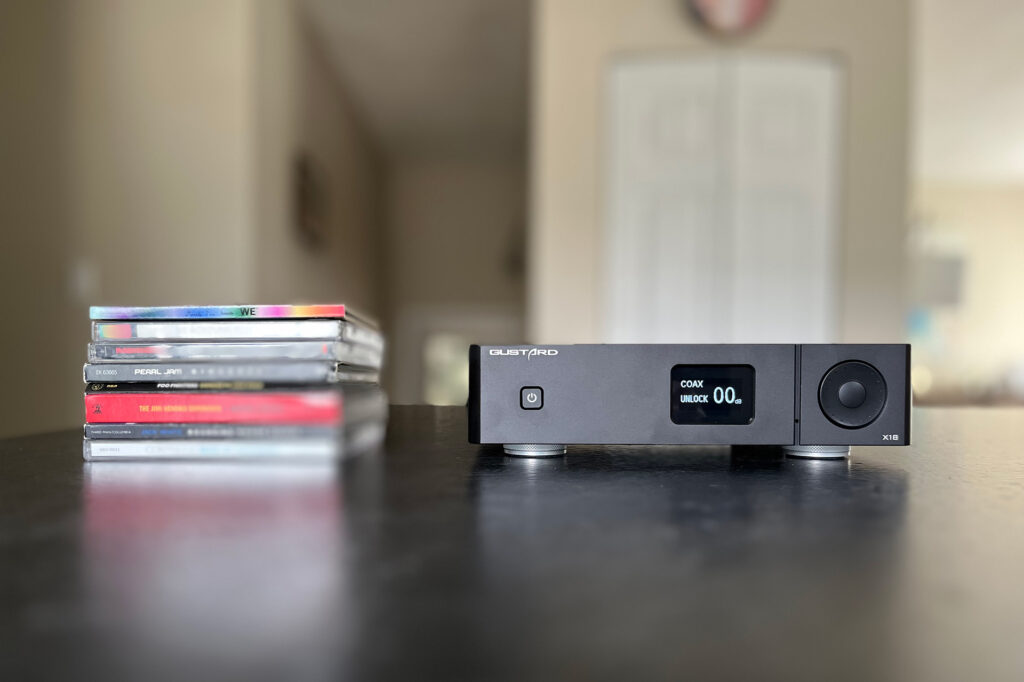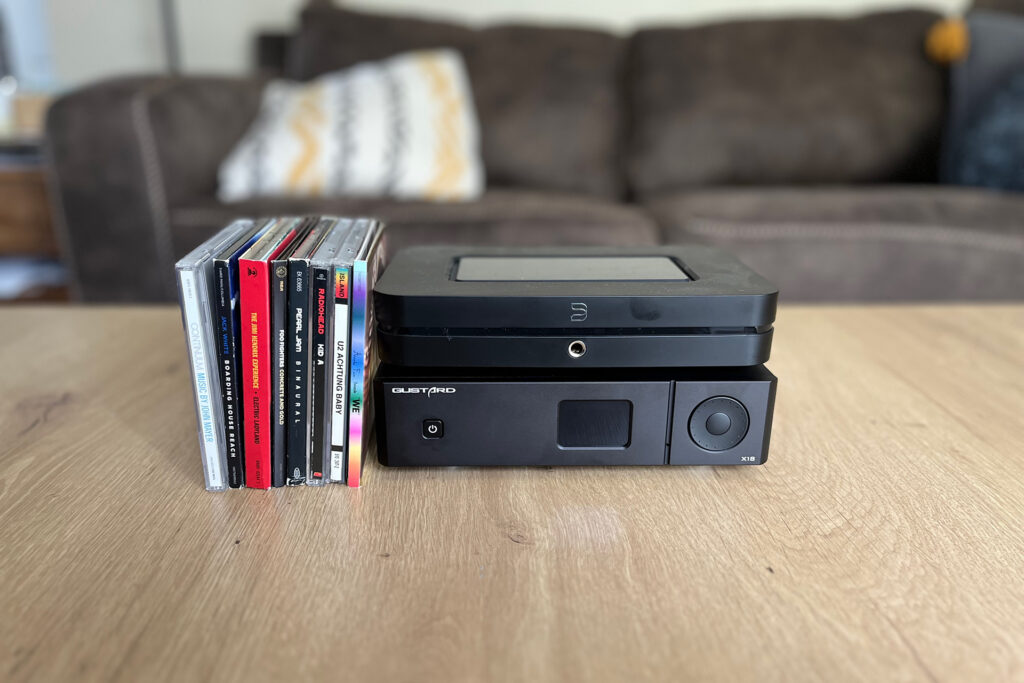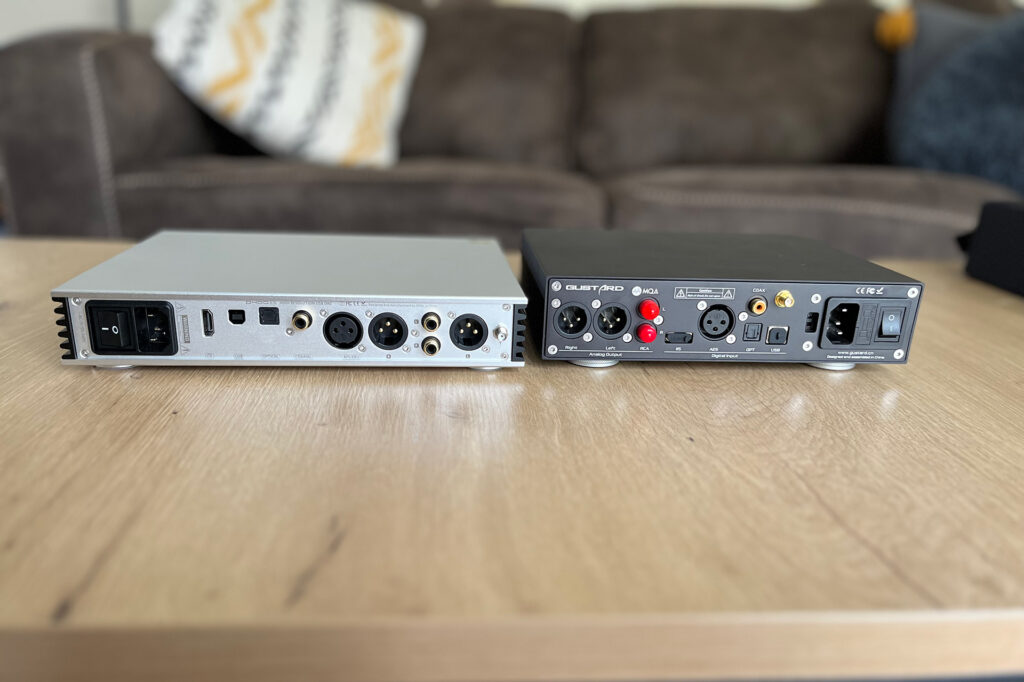One of the most popular conversations in the audiophile community today is centered around the value of Chi-Fi DACs. With companies like Topping, which have products that are priced at $1,000 (and lower) that can punch many times above their weight class, we wanted to explore some of the other popular Chi-Fi DACs that are in that same price range to see how they performed.
Gustard is one of the other more well-known, performance-oriented brands in this emerging audiophile product category that has people talking. We were able to procure their Gustard DAC-X18 to see how it performs in some real-world subjective listening tests – often with a volume-matched A/B test. The Gustard DAC-X18 DAC features the ESS ES9038Pro chipset, and comes equipped with balanced and unbalanced outputs, coaxial, optical, USB-B, IIS-H, and AES inputs. If that isn’t enough, it also has Bluetooth 5.0, with support for AptX HD and LDAC. The Gustard DAC-X18 is also capable of PCM 32-bit/768 kHz, DSD512, and can fully unpack MQA files (not that those are all that relevant anymore, but it is nice to have legacy support). If you’re looking for filters (AKA: EQ settings in your DAC), the DAC has seven PCM filters and four DSD filters. All of this is packed into a half-width case, so let’s check it out.

What Makes the Gustard DAC-X18 DAC So Special?
- It is rare to find I2S and AES digital in inputs at this price point on an “affordable” DAC. I struggled to find a DAC from a Western company that had an I2S output for less than $1,500, which is nearly double the cost of the DAC-X18, let alone both I2S and AES.
- Balanced outputs and volume control allow you to skip the preamplifier in digital-only situations. If you’re someone who is just getting started and has no intention of adding an audiophile turntable, there is a case to be made that you don’t really need a stereo preamplifier, which could save you a significant amount of money that you can put toward either your floorstanding loudspeakers or the power amplifier of your choice.
- There are lots of filters (aka: EQ) to choose from. When I say lots, I mean there are seven filters for PCM and four filters for DSD. That is a lot of filters at any audiophile price point. I would expect there is going to be a filter there that each user can find that is to their liking. We never engage the filters when testing a DAC, as we want to hear what the unit can do without any EQ but, by all means, if you find an EQ setting that you like, give it a listen.
- The build quality of this Chi-Fi DC is really fantastic. My expectation was that the DAC would feel light or cheap, but the Gustard DAC-X18 is built like a tank. The casing is made of solid metal (no plastic, per se), and it has proper feet to dampen vibrations, which audiophiles always love. I’ve got a feeling that I could throw this DAC out a third-story window, go pick it up and plug it in and, aside from a few scratches, it would still work. I am not going to try that – it is just a feeling.
Why Should You Care About the Gustard DAC-X18 DAC?
If you’re in the market for an upgrade to your digital sources, a separate DAC is a great way to go. The issue often is, especially if you don’t have a budget in the thousands of dollars, the cost of getting the performance boost. Most integrated amplifiers and many preamplifiers today come with a DAC included, as do many worthy audiophile sources. However, their features and connectivity options are often limited, even if they use a killer DAC chip set. The power supply is also shared, not dedicated to the DAC, as you find with the Gardard DAC-X18.

Some Things You Might Not Like About the Gustard DAC-X18 DAC
- The remote on the Garard DAC-X18 feels flimsy and cheap. This is a really common complaint for a lot of gear priced under $1,000, and the DAC-X18 is no different. The remote is well-labeled, but I am always concerned with cheap remotes about how easily they might break when dropped or just heavily used in a real-world setting. If you’re using a preamplifier or some form of tablet for control in your rig, this isn’t as big a deal, but if you’re going to use the DAC as a preamp as well, you need the remote to work well for you. With a little work, I bet there is a universal remote that can get the job done in your audiophile system in a more slick and robust way.
- If you need support, you shouldn’t expect it to come quickly. With email-only support, and no real traditional AV dealer to rely on, any issues you might run into mean that you are likely getting your issue resolved in days, instead of minutes or hours.
- The Gustard DAC-X18 doesn’t come preset to the North American voltage. This is a relatively small complaint, but when the DAC comes only with a North American power cord, you don’t expect to need to toggle the voltage switch. This is a headache that could be easily resolved if the company addressed it prior to packaging the device for shipping.
- The Gustard DAC-X18 is half-rack-width. In a professionally-installed rack (think: pro audio or studio applications), a half-width component can be an efficient use of space. For those with traditional width (17-inch) components, there can be visual or setup issues, depending on your specific installation.

Listening to the Gustard DAC-X18 DAC …
I tested the Gustard DAC-X18 DAC with my Anthem STR preamplifier in and out of the signal chain. In both cases, I used a Bluesound Node (2024) and a Music Hall CD25.3 CD player, and an Anthem MCA 225 Gen 2 amplifier played through Paradigm Premier 700F floorstanding speakers. I was also able to AB-test the Gustard DAC-X18 with the S.M.S.L. D400EX DAC (buy at Amazon), which I also have in for review concurrent with the Gustard DAC-X18.
I started with John Mayer’s “I Don’t Trust Myself (With Loving You)” (Qobuz 96 kHz) from his 2005 album Continuum. This is Mayer’s third album, and his most critically acclaimed. This was also Mayer’s last traditional pop/rock album, before he started to go and explore other genres, especially the Blues and more folk/country sounds. The track is laid back and features lots of Mayer’s guitar solos, but also features some fantastic studio musicians as well, which helps make this track stand out. When listening to this track on both the Gustard DAC-X18 and the S.M.S.L D400EX, with the Gustard, the bass was noticeably more defined, and it also sounded more forward in the overall mix/soundstage. Otherwise, the finer points of the track were pretty much equally detailed, and neither DAC sounded warmer or colder than the other on this track. Remember, the delta in performance from these somewhat affordable DACs and the much more exotic ones can be somewhat slim, and often very much in the high frequencies. The percentage of performance that you get from these more reasonable DACs is well above the built-in DACs in sources and preamps, but not all that much above DACs with much fancier designs and implementations.
Whenever I am reviewing an audiophile-grade DAC I love to go to Arcade Fire’s “Age of Anxiety I” from their 2022 album WE. This is a fantastic track from this art-rock band. It is well-recorded and full of nuance, especially in the second half of the song, after a mostly acoustic first half. When AB-testing this track between the S.M.S.L DX400EX and the Gustard DAC-X18, both DACs held their own. To my ear, the piano at the start of the track sounded a little bit more vibrant or perhaps realistic through the DAC-X18, and the vocal tracks near the middle of the track were a little clearer as well, as you could easily to match the whisper of Régine Chassagne to her other vocal parts, whereas with the S.M.S.L. DAC, I wasn’t able to ascertain that it was her voice.
Another track that I used to test the Gustard DAC-X18 is “Corporation” (Qobuz 96 kHz) from Jack White’s 2018 album Boarding House Reach. This is the third track on the album, and it is a mostly instrumental track, with minimal vocals. This is a great all-around track to use when trying to understand the performance of the DAC, as it has a noticeable bass track and a lot going on, without being incredibly dense. Comparing the Gustard to the S.M.S.L with this track, the Gustard DAC-X18 had a much livelier sound. The bass extension was considerably more present, and the instruments were much easier to separate, which is ideal in a track like this that has so many different sounds occurring.
Will the Gustard DAC-X18 DAC Hold Its Value?
At the current price of the DAC, I wouldn’t hold my breath to get a great return, given you only paid $700 for it, so 50 percent back is the typical expectation. Now, politics being what they are, having one of these DACs in hand prior to massive tariffs likely coming into play could allow you to get a much bigger return, as the price could be raised by up to 125 percent or more.
In the end, a DAC like the Gustard DAC-X18 will deliver the value that you paid for it many times over as the barrier to entry in terms of price is so low. Simply put, it is hard to get hurt buying a component like the Gustard DAC-X18, but we all know the risks when making Chi-Fi investments. I personally think any potential risks are well worth it for the value-oriented audiophile.

What is the Competition for Gustard DAC-X18 DAC?
The Topping D70 Pro Sabre ($715 – Buy at Amazon – review pending) is an option in the same price range as the Topping D70 Pro Sabre. This DAC uses the ESS ES9038Pro chip and has many of the same features as the Gustard, with one exception. The Gustard has an ISS input, which is very rare at this price point. It is easy to see the sonic similarities on paper. Which DAC is right for you might require you to do the Pepsi Challenge at home in your audio system.
The S.M.S.L. DX 400 HIFI Fever ($960 – buy at Amazon). If you have a slightly higher budget, you could look at the DX 400 HiFi Fever from S.M.S.L. S.M.S.L. is another popular Chi-Fi brand, and the brand of the first product ever reviewed here at FutureAudiophile.com. This S.M.S.L. DAC uses two AK4499EX chips and an AK4191 chip, and has all of the same inputs as the Gustard DAC-X18.
The Schiit BiFrost ($799). If you’re looking for a DAC with a potentially less tariff-impacted price, I would look at the Schiit BiFrost. It is slightly more expensive, but you can be confident that the price isn’t going to move around too much, as all of Schiit’s products are made in America. It is a fully-balanced design and has many of the same input options as the Gustard. However, it doesn’t have the high-end input options of IIS and AES. AES is only an option in the next model up from Schiit, the Gungnir 2.

Final Thoughts on the Gustard DAC-X18 DAC …
I am among the first, when people start talking about how good Chi-Fi gear is, to raise an eyebrow. The idea that a quality piece of audiophile-grade gear could be sold for significantly less than a comparable piece to me sounds far more like hype than it does reality. Wanna know why Chi-Fi is worthy of your consideration in 2025? There are actually uber-high-end audiophile companies furious with our publication for even covering products like under-$1,000, Asian-made affordable gear. Their jealousy and fear-based tactics tell you that you might just be barking up the right tree if you are looking for an audiophile value, because this DAC sounds really good. Really transparent.
The Gustard DAC-X18 is a quality DAC that is worthy of your consideration if you’re shopping anywhere in the $750 range. Will it perform as well as a $5,000? I can’t really say, as I didn’t have one here to A/B test with it directly, but what I can say of the three Chi-Fi DACs that I have had to review is that the Gustard is my preferred option, although all of them are very capable and all of them could happily end up in my rig. The Gustard DAC-X18 DAC brings you closer to the studio sound of your favorite tracks, and it has features that will keep this DAC in your system for a long time.




Just to be clear, would the DAC-X18 be damaged if you plugged it into a U.S. 120V wall socket without flipping the voltage input from 230V? I’d not think so, but good to know for those who might accidentally do that. If the price goes much higher due to tariffs, like you, I’d probably get the American made Schiit BiFrost 2/64 and be happy knowing you can get service fairly easily if the need arises. The BiFrost also has upgradability in mind down the road – at least in theory, depending on whatever Schiit decides – so there is that to consider as well.
The Schiit Bifrost is not really a comparable if you have a dsd collection. Excellent DAC for the money, but not a direct substitution in that use case.
You mentioned you listened with the preamp both in and out of the system I wish you would have gone on to reveal the results. I read a review here of a preamp where the reviewer mentioned in his experience the sound was better with a preamp. That has been my experience as well.
Some may not think this is a big deal, however, it could give a newcomer the wrong idea that they don’t need a preamp. Well, need, may not be the proper word as you can certainly listen without one folks should at least have the nudge to try one.